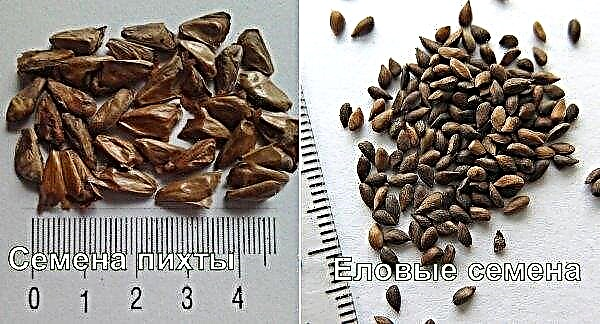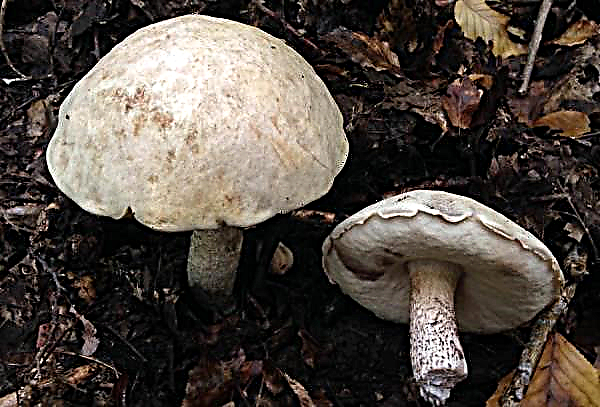In the world there are about 32 thousand varieties of Saintpaulias (violets). Of these, more than 2.5 thousand were bred by breeders of the USSR and the CIS. The new varieties include Le Isadora, a chic violet that owes its appearance in 2011 to the successful Ukrainian breeder Elena Lebetskaya. This article is about how to properly grow this violet at home.
What does it look like
Le Isadora is distinguished by tenderness and grace, which is why it is named after the famous graceful dancer. This variety belongs to fantasy violets, which stand out in bright fantastic colors.
The external characteristics of Le Isadora include the following characteristics:Did you know? The ancient Gauls considered violet a symbol of shyness and modesty, and the French considered loyalty and constancy.
- flowers are large (4-5.5 cm in diameter), double and semi-double, fleshy petals, velvet to the touch, openwork around the edges, buds bloom for a long time, within 2 weeks, resemble rose buds;
- the color is white and pink with bright patterns (spots, dots, strokes) of raspberry, lilac and purple hues; new buds have a green border that gradually disappears;
- flowering is plentiful and long, but in hot and cold weather the flowers quickly fade;
- peduncles are short, but weak, can not always support the weight of heavy flowers, which can be from 3 to 6 pieces;
- large foliage, dark green in color, with a pink tinge on the back, heart-shaped;
- the socket is standard, of the correct form, gives cuttings.
What conditions should be created at home
Despite its elegance and chic appearance, Le Isadora is capricious and undemanding. Nevertheless, she needs certain conditions. Then she willingly and abundantly releases the buds.
Placement and lighting
The homeland of Saintpaulia is the African continent, where it is always warm and sunny. This explains Le Isadora’s need for plenty of sun for at least 12 hours. She will be comfortable in a sunny place, but not in direct sunlight, which can burn leaves and flowers.
A suitable place for violets in the apartment may be the windowsill of the east or west window. If only the south window is available, then in the summer afternoon it should be covered with curtains to protect the flower from sunburn. The north window is not suitable, because there is not enough light. Because of this, the senpolia will not want to bloom. In the absence of a brighter place in the room, you will need to take care of artificial lighting with a fluorescent lamp.
Video: violet varieties le Isadora
Temperature and humidity
African violet is very thermophilic, does not tolerate low temperature and does not like sharp temperature fluctuations day and night. She feels good during the day at a temperature of +20 ... + 25 ° С, and at night - at + 18 ° С. Drafts are dangerous, so in the cold season it is better to relocate the flower from the through window to the whatnot.
Le Isadora loves neither too humid nor too dry air. She accepts an average humidity of 50%. It is not necessary to spray a flower. Only in the case of increased air dryness, especially in winter due to heating devices, it is possible to moisten the air around the plant with a spray gun.
Did you know? Among the ancient Greeks, the violet color symbolized love and fertility. Therefore, they used violet to make a love potion and wine.
How to care at home
African flower unpretentious. Le Isadora does not require more attention than other senpolis. It’s not difficult to take care of her.
Watering
For the senpolis, including Le Isadora, the “golden rule” of flower growers is especially relevant: “it’s better not to fill than to overfill”. Overmoistening of the soil and stagnation of water in the pot should not be allowed. This leads to diseases and decay of the roots and stem. Watering is necessary as necessary, which can be determined by the dried topsoil. The frequency of watering depends on the time of year. In the summer, when the earth dries quickly, you need to water it in a day or two, and in winter less often - about 2 times a week.
It is not recommended to water the violet with cold tap water. The fluid should be warmed to room temperature. It is best to stand up for three days from the tap water. So it will heat up and clean up a bit, as harmful light impurities will evaporate, and heavy ones will settle to the bottom.
There are 3 ways to water Saintpaulia:
- Top, or in a pot: Pour water carefully along the edge of the pot, trying not to fall on the leaves and in the center of the outlet.
- Lower, or in the pallet. You can use a wide tank with water, into which the pot is immersed for half an hour. Then you need to allow excess fluid to drain. The advantage is that there is no danger of over-wetting the earth. The plant will take as much water as it needs.
- Wick way: water enters through a wick (lace made of synthetic fabric), one part of which is laid at the bottom of the pot under the roots, and the other hangs from the hole at the bottom into a container of water over which the pot is fixed. The advantage of this method is that it eliminates the possibility of waterlogging and drying of the soil.
Important! In winter, in a cool room, wick watering should be abandoned. Under such conditions, the roots may rot.
Fertilizer application
All indoor violets love top dressing; Le Isadora is no exception. Timely application of the right mineral fertilizers promotes rapid growth and lush year-round flowering. The optimal frequency of top dressing is 2 times a month.
It is necessary to pay attention to the composition of top dressing, because at different periods of development, the flower needs different nutrients. Young bushes and children need fertilizer with a high nitrogen content, which helps to build green mass. And when the outlet releases buds and blooms, it already needs more potassium and phosphorus, and the amount of nitrogen is reduced to a minimum.
Pruning
Senpolis of Le Isadore does not need pruning. But to improve the appearance, you can pinch the lower leaves. They are removed, since they lose the brightness of the color and take away from the plant the forces necessary for flowering. For the same purpose, you should get rid of children who have yellowed leaves and peduncles with faded buds. Usually, excess elements are not cut off, but cut off.
How to transplant
Experts recommend replanting the Ispal Senpolia annually. This is usually done in spring, but not during flowering. A transplant is necessary for updating the soil in the pot, since in a year it manages to be depleted. For this purpose, purchased soil for the senpolia is perfect.
You can prepare the substrate yourself by mixing 4 types of soil:
- peat - 1 part;
- coniferous - 1 part;
- turf - 2 parts;
- sheet - 3 parts.
So that the earth is loose and easily passes moisture and air, loosening substances should be added to it:
- vermiculitis;
- perlite;
- sphagnum;
- coarse sand.
Important! Clay and ceramic pots are not suitable for Saintpaulia, since the earth in them quickly dries and settles over time. Better to use plastic flowerpots.
In addition, if the flower has grown and there is not enough space in the pot, it will need to be changed to a more spacious one. The root system grows shallow, and is located in the upper layer of the earth. Therefore, the capacity should be shallow. Its diameter is also small (6–9 cm). In a larger or smaller pot, the plant will be uncomfortable, which will affect flowering. There must be drainage holes and a drainage layer (expanded clay, small pebbles) at the bottom of the dishes.
Depending on the purpose, the transplant is carried out in 2 ways:
- Full soil renewal - it is necessary when the flowers were crushed, and the earth became very dense and poorly leaks moisture. The plant is carefully removed from the pot, the roots are cleaned of the ground and dead elements (dry, sluggish or rotten) are removed, the sections are treated with carbon powder. Then the flower is placed in a pot with a prepared substrate.

- Transshipment - needed when the root system has braided the entire earthen lump and a larger pot is needed. The plant is thrown out of the dishes with a lump without cleaning the roots, and placed in a prepared pot with drainage, adding new earth if necessary.

How to propagate at home
Le Isadora is usually propagated in two ways: a leaf and a rosette cuttings. Let's consider each of them.
Propagation by cuttings is performed as follows:- On the uterine bush, the children are cut with a sharp knife and the largest of them are selected for planting (about 4 cm in length).
- Selected cuttings are placed in cups with standing warm water and placed in a sunny place.
- When the roots appear, you can transplant them into the smallest pots with a substrate for violets.
- It is desirable to water the bottom way.

Reproduction by leaves is carried out in a similar way:
- In the outlet of the adult senpolia, a healthy leaf is selected without a flaw and broken off or cut together with the petiole. The upper leaves are not suitable, only the lower ones.
- A cut is made on the petiole of the selected leaf at an angle of about 45 ° C and left for 20 minutes to dry.
- The sheet is put in a glass of water with the foot down and sent to a sunny place.
- When the roots appear, the stalk is planted in a small pot with a special substrate.

What are the difficulties when growing
Like other varietal senpolia, Le Isadora can get sick and be attacked by insects. The most common cause of these problems is violations of the rules for caring for the flower. Consider these difficulties and methods of dealing with them.
Disease
- powdery mildew - white coating on the foliage: the method of struggle - Fundazol;

- late blight - rotting of the roots and brown spots on the green: the diseased plant is destroyed;

- fusarium - decay of the surface of the flower: the affected areas are cut and treated with fungicide;

- gray rot - gray spots on the foliage: sore spots are cut off, treated with fungicide, the violet is transplanted into new land.

Pests:
- different types of ticks can be recognized by cobwebs and brown holes on the leaves: control agents - acaricides;

- shields recognized by sticky spots on the leaves: Agravertin will help;

- thrips flowers and foliage are affected: you need to cut off all the flowers and use Actara.
























